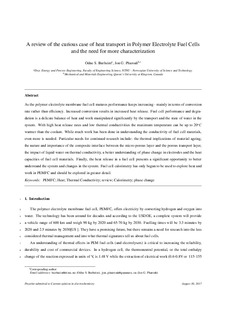| dc.contributor.author | Burheim, Odne Stokke | |
| dc.contributor.author | Pharoah, JG | |
| dc.date.accessioned | 2018-01-02T08:47:43Z | |
| dc.date.available | 2018-01-02T08:47:43Z | |
| dc.date.created | 2018-01-01T13:58:43Z | |
| dc.date.issued | 2017 | |
| dc.identifier.citation | Current Opinion in Electrochemistry. 2017, 5 36-42. | nb_NO |
| dc.identifier.issn | 2451-9103 | |
| dc.identifier.uri | http://hdl.handle.net/11250/2473891 | |
| dc.description.abstract | As the polymer electrolyte membrane fuel cell (PEMFC) matures performance keeps increasing—mainly in terms of conversion rate rather than efficiency. Increased conversion results in increased heat release. Fuel cell performance and degradation is a delicate balance of heat and work manipulated significantly by the transport and the state of water in the system. With high heat release rates and low thermal conductivities the maximum temperature can be up to 20 °C warmer than the coolant. While much work has been done in understanding the thermal conductivity of fuel cell materials, even more is needed. Particular needs for continued research include: the thermal implications of material ageing, the nature and importance of the composite interface between the microporous layer and the porous transport layer, the impact of liquid water on thermal conductivity, a better understanding of phase change in electrodes and the heat capacities of fuel cell materials. Finally, the heat release in a fuel cell presents a significant opportunity to better understand the system and changes in the system. Fuel cell calorimetry has only begun to be used to explore heat and work in PEMFC and should be explored in greater detail. | nb_NO |
| dc.language.iso | eng | nb_NO |
| dc.publisher | Elsevier | nb_NO |
| dc.rights | Attribution-NonCommercial-NoDerivatives 4.0 Internasjonal | * |
| dc.rights.uri | http://creativecommons.org/licenses/by-nc-nd/4.0/deed.no | * |
| dc.title | A review of the curious case of heat transport in polymer electrolyte fuel cells and the need for more characterisation | nb_NO |
| dc.type | Journal article | nb_NO |
| dc.type | Peer reviewed | nb_NO |
| dc.description.version | acceptedVersion | nb_NO |
| dc.source.pagenumber | 36-42 | nb_NO |
| dc.source.volume | 5 | nb_NO |
| dc.source.journal | Current Opinion in Electrochemistry | nb_NO |
| dc.identifier.doi | 10.1016/j.coelec.2017.09.020 | |
| dc.identifier.cristin | 1533262 | |
| dc.description.localcode | © 2017. This is the authors’ accepted and refereed manuscript to the article. Locked until 6.10.2019 due to copyright restrictions. This manuscript version is made available under the CC-BY-NC-ND 4.0 license http://creativecommons.org/licenses/by-nc-nd/4.0/ | nb_NO |
| cristin.unitcode | 194,64,25,0 | |
| cristin.unitname | Institutt for energi- og prosessteknikk | |
| cristin.ispublished | true | |
| cristin.fulltext | postprint | |
| cristin.qualitycode | 1 | |

